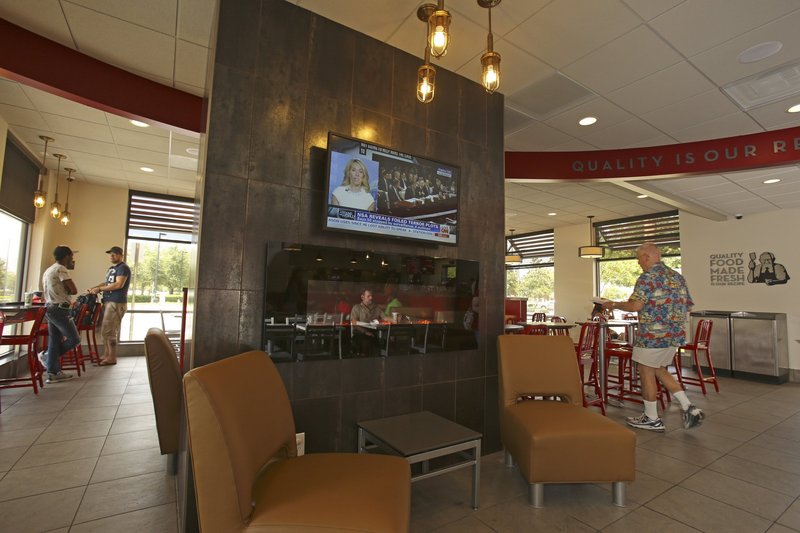Mike Parson didn’t feel as if he were in a fast-food joint at a newly renovated Orlando, Fla., Wendy’s with a lounge, faux fireplace, Wi-Fi and separate counters for orders and pick up.
“It feels more like a hangout,” said Parson, a 22-year-old University of Central Florida student.
That’s exactly what Wendy’s was aiming for — more of a Panera Bread vibe — with its design in the restaurant interior, which will be used in new and remodeled restaurants from now on.
“We’re moving a little bit toward the fast-casual,” said Craig Madanick, a Wendy’s field-marketing manager. “We feel it’s necessary for us to stay competitive and gain the upper edge to offer a new environment to our consumers.”
America once had very specific kinds of restaurants. There was fast food for a quick bite, casual dining for a fun night out, and fine dining for that really special occasion. But now those lines are getting fuzzier.
As they struggled to lure more customers during the Great Recession, some chains began looking to broaden their appeal.
“The blurring is definitely occurring,” said Bonnie Riggs, restaurant analyst for the research company NPD Group. “They’re trying to find all kinds of ways to drive visits.”
Wendy’s changes are happening even as Panera Bread Co. has turned to one of fast food’s standard features: the drive-through lane.
Red Lobster is trying pay-at-the-counter service. And the Melting Pot is encouraging fondue diners to come in for something a little simpler than its elaborate four-course meal.
Fine-dining restaurants have become more casual, Riggs said, and more focused on their bar business.
Ruth’s Chris Steak House, owned by Ruth’s Hospitality Group, last year introduced a “Sizzle, Swizzle, Swirl Happy Hour” bar menu, with food costing far less than the steakhouse entrees.
The goal is to “turn many first-time, often younger, guests into Ruth’s Chris regulars,” Chief Executive Officer Mike O’Donnell told analysts last month.
Fleming’s Prime Steakhouse & Wine Bar has a “5 for $6 ’til 7” bar menu that includes baked brie and pan-crisped pork belly.
The Melting Pot has often been a spot for special occasions. But a menu makeover was meant to encourage customers to stop in for a more casual visit. The company’s website assures diners it’s just fine to stick with cheese and chocolate fondues rather than the pricier entrees.
“Restaurants are really competing for every dollar, and they have to reinvent themselves,” said Sandy D’Elosua, the chain’s marketing director.
Two new categories have evolved and flourished the past few years: fast casual and polished casual. Fast-casual restaurants such as Panera Bread are a step up from fast food and a tad more expensive. Customers order and pay at the counter, but the food tends to be fresher and more sophisticated.
Polished-casual restaurants such as the Cheesecake Factory, meanwhile, offer more contemporary fare and atmospheres than a typical TGI Friday’s or Olive Garden. So, as casual-dining restaurants have lost ground to their quicker, cheaper competitors, some are saying, “If you can’t beat ’em, join ’em.”
Red Lobster, owned by Darden Restaurants, has begun testing “Seaside Express,” a pay-at-the-counter lunchtime option, in two Orlando-area restaurants. Applebee’s is trying a similar concept. The lunchtime options are quicker, and there’s no obligation to tip.
Even the successful fast-casual restaurants, though, are borrowing from other categories — and it’s boosting the bottom line.
For a long time, Panera Bread took the view that “we will never have a drive-through; we don’t want to be portrayed or thought of as a fast-food type of operation,” said Gavin Ford, who owns Central Florida Panera franchises.
But that has changed. And the 27 Orlando-area bakery-cafes with drive-through lanes have seen sales jump by up to 35 percent, Ford said.
Customers “want more choices, more options,” he said. “People are just more demanding these days.”
Copy the Story Link
Send questions/comments to the editors.



Success. Please wait for the page to reload. If the page does not reload within 5 seconds, please refresh the page.
Enter your email and password to access comments.
Hi, to comment on stories you must . This profile is in addition to your subscription and website login.
Already have a commenting profile? .
Invalid username/password.
Please check your email to confirm and complete your registration.
Only subscribers are eligible to post comments. Please subscribe or login first for digital access. Here’s why.
Use the form below to reset your password. When you've submitted your account email, we will send an email with a reset code.